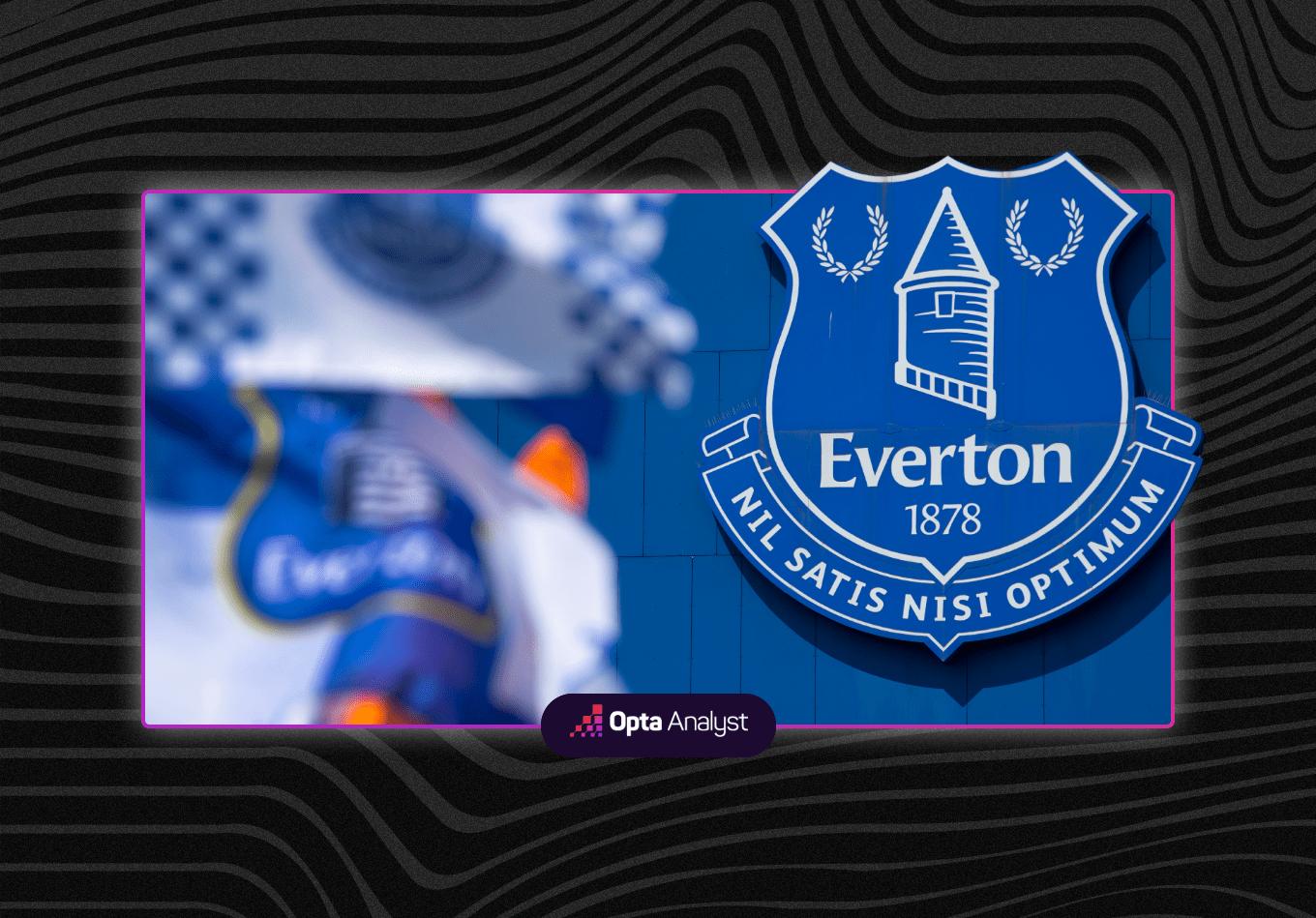After battling relegation in successive seasons, Everton need to finally pull themselves together if their long stay in the top flight is to go on.
Much must change at Everton.
Financial mismanagement, poor recruitment and questionable managerial appointments have resulted in a club that was considered ‘the best of the rest’ not so long ago sinking into two relegation battles in as many seasons.
While the days of David Moyes guiding Everton to consistent top-six finishes on a shoestring budget are long gone, it was not that long ago that the Toffees appeared ready to challenge for, at the very least, a European place.
Yes, the hiring and firing of managers under Farhad Moshiri has been a big part of the problem, but Everton finished eighth under Marco Silva in 2018-19, and then in 2020-21 – played mostly behind closed doors when football seemed to be played constantly to fill the drudgery of lockdowns – they were in the Premier League’s top four as late as March.
Carlo Ancelotti left at the end of that campaign, and realistically, the chance of one last hurrah for the Moshiri era went with the Italian. Rafael Benítez’s appointment was doomed from the start; Frank Lampard was a poor replacement. Now, the stability of Sean Dyche must be Everton’s immediate future, though the Toffees flew so close to the sun over the past 18 months that the only surprise is they haven’t melted away entirely. After scraping survival yet again, Everton have serious issues to address off the pitch, but also on it, if they are to avoid a third straight relegation battle.
The Attack
Let’s get one thing straight: Everton’s problem lies deeper than just scoring goals, and we’ll come to that in a while. But their main issue was, for much of the season, putting the ball in the back of the net. It’s kind of the aim of the game, and they were not very good at it.
Only Wolves (31) scored fewer Premier League goals than Everton (34) in 2022-23, with even bottom club Southampton managing more (36). Indeed, only one player (Dwight McNeil) hit 10 direct goal contributions in the top flight.
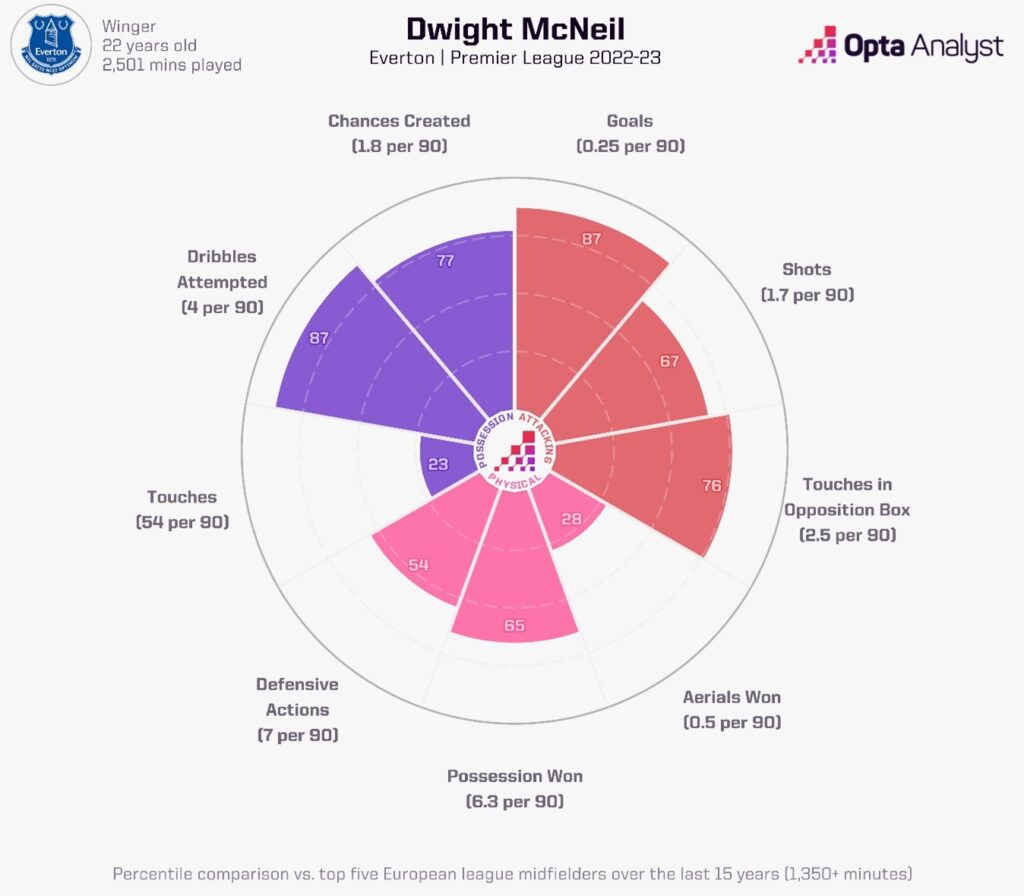
Five (14.7%) of Everton’s goals in the league came in one game – that stunning 5-1 win over Brighton and Hove Albion on 8 May; the result ultimately helped put fate into their own hands in the run-in.
When it came to creating opportunities, Everton were slightly better. While Wolves are also the worst-performing team when it comes to expected goals (37.8), the Merseyside club were up in 15th for this metric, with 45.8.
Set pieces were an especially useful route to creating goalscoring chances for Everton. Indeed, through a dismal post-World Cup period in late December and all of January, three of Everton’s final four league goals under Lampard came from set-pieces – a Yerry Mina header from a corner against Wolves on Boxing Day; Demarai Gray’s penalty in a 4-1 home loss to Brighton; and Amadou Onana turning home a Gray delivery in a 2-1 defeat to Nathan Jones’ Southampton that was the nadir of a dreadful campaign.
Dyche – unsurprisingly – looked to utilise this relative strength from set-play situations, and James Tarkowski’s winner against Arsenal in the former Burnley boss’ first game in charge at Goodison Park came from a deep corner to the back post from McNeil.
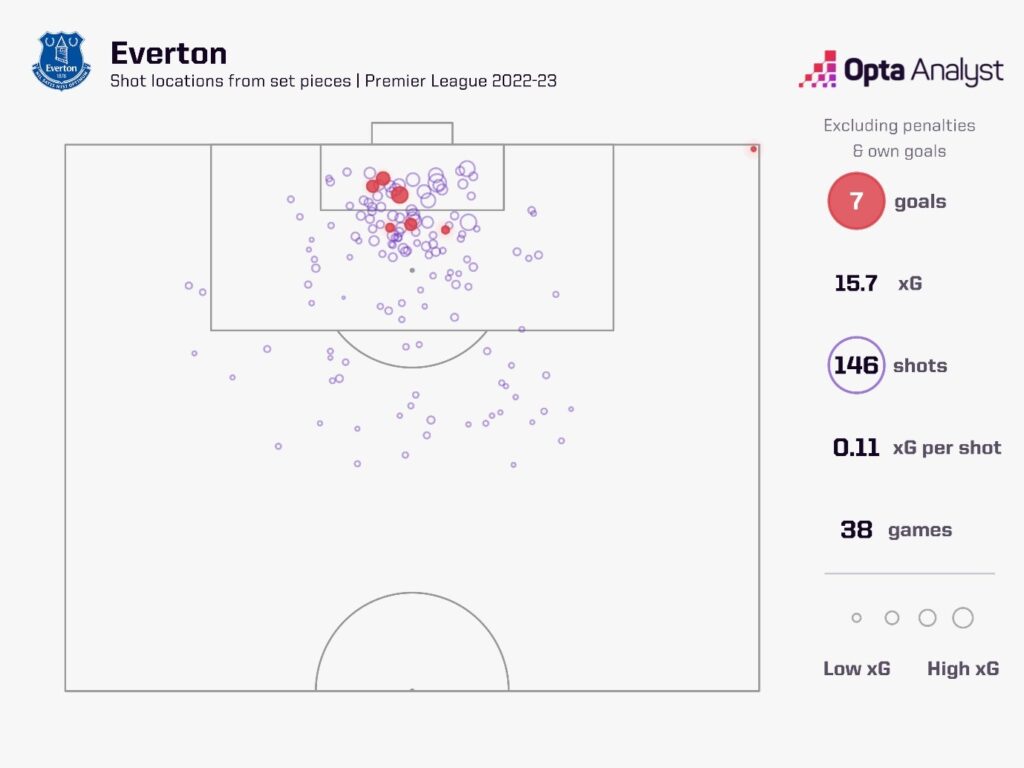
However, even from set plays, the issue was finishing the opportunities they did manage to craft.
Across the whole season, Everton had the third highest xG total from non-penalty set pieces (15.7) and the highest percentage of their total xG from these situations across the entire league (34%). However, only Wolves (six), Brighton (six) and Manchester United (five) scored fewer set-piece goals than Everton’s seven.
Fixing the attack must be Everton’s priority. Having sold Richarlison, they gambled on Dominic Calvert-Lewin’s fitness last year, for the second season running. The England international sustained an injury in training on the eve of the campaign, yet Everton did not manage to recruit a forward until late August, when Neal Maupay joined.
The sensibility in signing a striker who profiles completely differently to the first-choice – albeit injury-prone – centre-forward is questionable. Add in that Maupay, who cost a reported £10million, had underperformed his xG total in each of his three seasons in the Premier League with Brighton, and it was a signing that felt destined to fail from the off.
In fairness, Maupay had scored 26 league goals in 102 appearances for the Seagulls, so roughly one in four, but the Frenchman managed just one strike for Everton in 27 top-flight games in 2022-23.
New additions are needed to the forward line if Everton are to ensure they’re not fighting relegation for a third season running.
The Midfield
Much of Everton’s transfer spend in 2022 went on bolstering the midfield.
Onana was the big signing, for a reported £33m from Lille. Though the Belgium international had started only 11 Ligue 1 games in 2021-22, Lampard quickly put him into the starting XI. It was only later in the season, under Dyche, that Onana occasionally dropped to the bench. James Garner, meanwhile, arrived from United, though a back injury limited his impact until the final weeks of the campaign. There was also the return of Idrissa Gueye from Paris Saint-Germain.
Despite that expenditure, Everton’s midfield is arguably in need of another revamp. Perhaps not a major facelift, but a lick of paint here or there wouldn’t go amiss.
Gueye might not be quite the same player as when he left for PSG in 2019, but he nevertheless still registered impressive numbers. His 266 recoveries was the most among Everton’s outfield players, and it was a similar story in terms of interceptions (56), tackles attempted (97) and possession won via tackles (57) in 2022-23. Gueye ranked third across the entire the league (excluding goalkeepers) for recoveries, behind only Declan Rice (334) and Rodri (301), joint-second behind Rice (63) for interceptions, third for tackles and joint-second for tackles won.
But he turns 34 in September. Tom Davies is out of contract and has headed to the exit door after failing to agree terms put forward to him for an extension. Garner is still raw at Premier League level, as is Onana. Box-to-box midfielder Abdoulaye Doucouré stepped up under Dyche and scored five goals, including the winner in that decisive final-day victory over Bournemouth.
Alex Iwobi provides the creativity, but in Dyche’s system was often forced wide. The Nigeria international created 57 chances from open play, 33 more than any other Everton player. His seven assists also led the squad. It is notable, though, that Iwobi outperformed his 4.33 xA, suggesting the quality of chances he supplied did not necessarily equate to the number of assists he finished with. McNeil, on the other hand, rounded off the season with 5.43 xA, yet only three of those opportunities were converted.
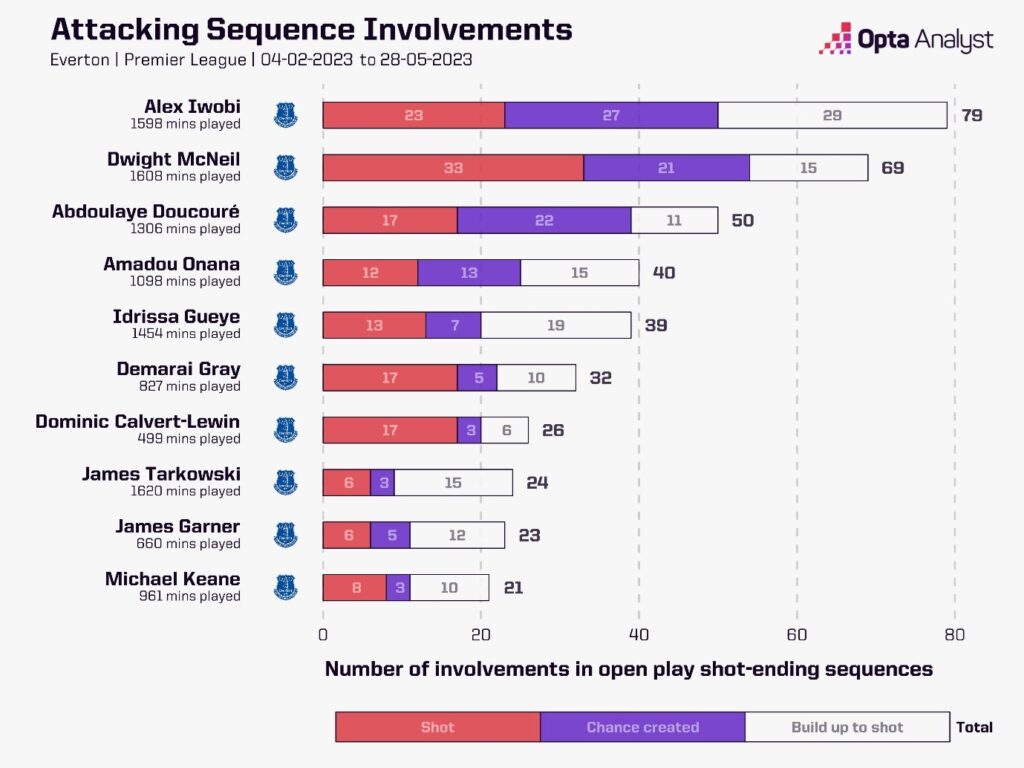
Everton cannot rely wholly on Iwobi or McNeil. In fact, the former is entering the final year of his contract and his erratic nature can be frustrating.
The lack of quality chances being created by Everton is evidenced by no player in their squad achieving a higher xG assisted per 90 average than the miserly 0.1 managed by both McNeil and Iwobi. Essentially, the Toffees’ two most creative players were laying on opportunities worthy of an assist only once every 10 matches.
If Everton are to part company with a player, Onana would seem a likely candidate, and some of those funds would have to be allocated to adding more creativity and threat to a central midfield unit that combined for just eight league goals, including Doucoure’s haul.
The Defence
As mentioned, Everton’s attack was far from the only problem. While the Toffees were given the “best defence in the league” tag after conceding just seven times across their first eight games of the season, the underlying metrics painted a far gloomier picture.
Everton’s xG against (xGA) over the same period was 13.1 (fifth highest), showing they were benefiting from luck when it came to keeping the opposition out, as well as the fine form of Jordan Pickford, who at that point was the Premier League’s form goalkeeper when it came to goals prevented.
Based on Opta’s xGOT model, which is useful for assessing goalkeeper performance, Pickford made 2.43 saves more than would have been anticipated based on the quality of opportunities he faced. The next best performer in this metric at that stage of the season was Bournemouth’s Neto (1.93).
Eventually, Everton’s luck ran out. By the time Lampard was sacked on January 23, Everton had accumulated 34.2 xGA, ranking them second-worst in the league, though their tally of goals conceded (28) had them tied for 11th – Pickford’s form having remained intact.
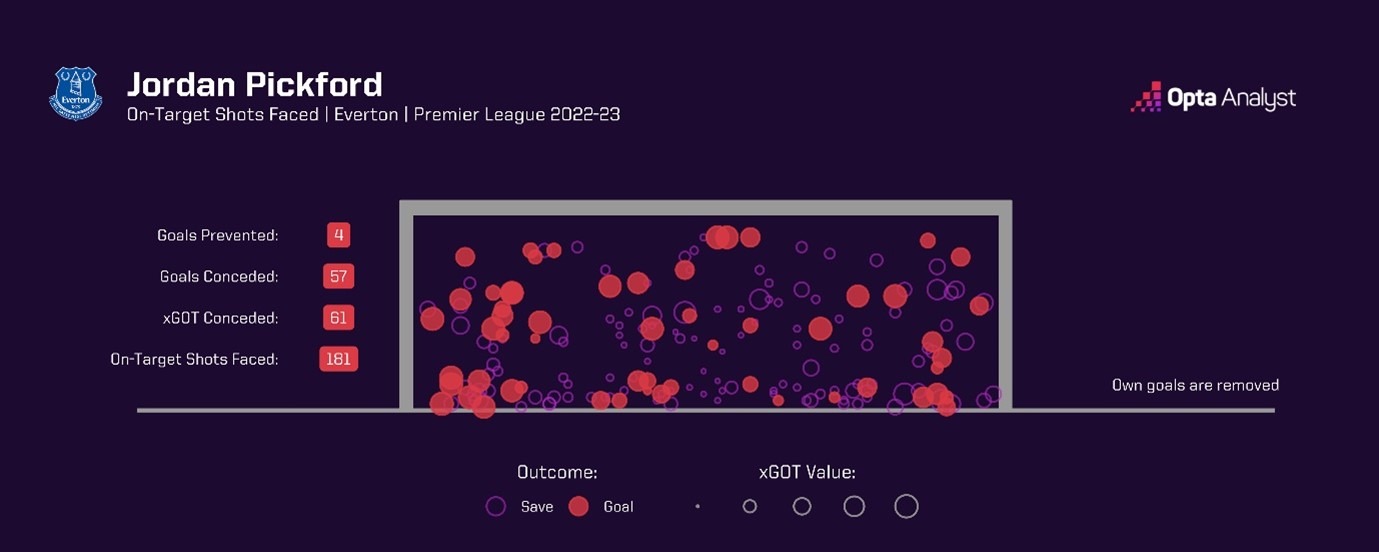
Somewhat surprisingly, while he found marginal gains in the attack, Dyche was unable to come close to solving the defensive issues. Everton accumulated 32.7 xGA across Dyche’s 18 matches, ranking 17th in the division.
Everton signed Conor Coady on loan from Wolves in August after losing both Mina and Ben Godfrey to serious injuries in an opening-day defeat to Chelsea, while Tarkowski had arrived on a free from Burnley.
Tarkowski was a staple of the team under both Lampard and Dyche and ended up being the only Premier League outfielder to play every minute of the campaign. Coady partnered him for much of the season until mistakes in defeats to Liverpool and Aston Villa resulted in Dyche turning to former Burnley centre-back Michael Keane.
That change didn’t work. In fact, Everton’s defence became weaker with Keane in the side. Across the 10 games he started, only Leeds United (22.7) had a worse xGA than Everton (20.9). After Mina came back into the team for the final four matches of the campaign, their xGA was 6.1 and they conceded only five times. The difference was stark, and Dyche should have turned to Mina sooner.
Mina will not be available next season, with the Colombian leaving on a free transfer after five years at the club. A brilliant defender when fit, Mina’s high wages and consistent injury issues meant he was always likely to leave given Everton’s dire finances. Coady has returned to his parent club, while Keane, Godfrey and Mason Holgate must be improved on.
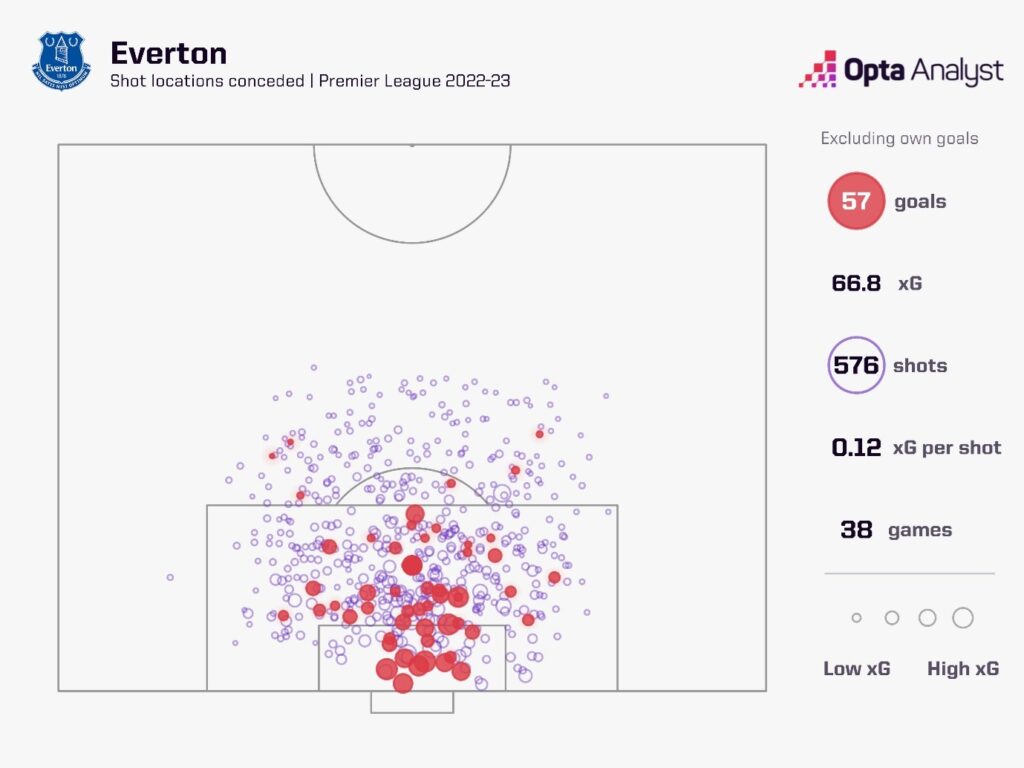
Jarrad Branthwaite is returning from a successful loan stint at PSV Eindhoven, but the 20-year-old might not be ready to come straight in and partner Tarkowski yet, so a high-calibre centre-back should be on Everton’s shortlist.
There are signings needed at full-back, too. Seamus Coleman is 34 and suffered a serious knee injury in May; Vitaliy Mykolenko is solid but offers little going forward from left-back; and the inexperienced Nathan Patterson has spent plenty of time out injured. The less said about Ruben Vinagre’s loan from Sporting CP, the better.
Overall, there’s much work to do in the transfer market and for Dyche on the training pitch, even if Everton manage to fix their off-field problems. The past two seasons have been a huge warning for the club, with relegation battles running down right to the wire. They don’t want an unwanted hat-trick in 2023-24.
Enjoy this? Subscribe to our newsletter to receive five stories each Friday. It’s free. And follow us on Twitter too.
